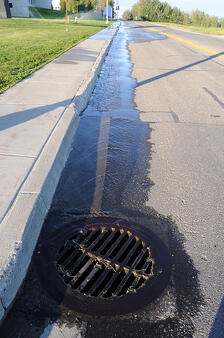Are your sights set on new goals for 2016? Instead of making your New Year’s resolutions about weight loss or excersing more, why not focus your energy by making a firm decision to reduce your commercial landscaping water next year? With the drought still looming around, why not consider making a firm commitment to reduce outdoor water by 25%- or even 30% ? Based on the latest trends and news, water rates are not going down anytime soon.
Lets begin with water conservation outside.
Here are some powerful ideas for Bay Area property owners that want to reduce water costs in their commercial property landscaping.
Controlled Water Flow Can Make a Difference with Water Conservation
One of most powerful tools in commercial landscape maintenance is water conservation and utility expense management plan that is equipped with a master control valve and flow meter.
The latest advancement in smart watering technology is being reached by better management of water flow through systems retrofitted with master valves and flow meters. Older systems that were not installed with these features are wasteful during unexpected water flow events.
Flow Sensors Can Detect Water Leaks in Commercial Property Landscaping
Some of the top Retail Centers and commercial property landscaping companies are using master valve controlling water flow and flow sensors on there landscaping irrigation systems, this helps detect how much water is going through smart watering irrigation systems, properties can now monitor water usage data literally down to the last sprinkler head. Having access to such detailed information is beneficial for any company looking to accurately measure their irrigation water costs
And the good news is that in addition to water savings, retrofitting older properties with this hardware technology is much more feasible and cost effective than ever before.
Retrofitting Irrigation Systems Is Now Easier Than Ever Before
One of most powerful tools for water management is to utilize a system equipped with flow sensing technology
Irrigation systems built as recently as a few years ago were often done so without these key components. While the technology has been around for quite some time, it’s been highly underutilized and almost impossible to retrofit because of the difficulty connecting to existing systems. Often, the points of connections are typically near the street and far away from controllers.
Previously, the only way to install a flow meter and a master valve was by trenching and wiring to the controller, which could be at the opposite side of the property. That meant trenching through parking lots, around buildings, utility fixtures and disrupting the landscape. The cost was not feasible for most properties.
Now, master valves and flow sensors can be linked to the closest irrigation wire rather than to the controller. What once may have taken 2,000 feet of wire has been reduced to 20-40 feet.
The beauty of the master valve/flow sensor combination is that the valve manages the amount of water going through the system and the flow sensor reports how much is being consumed and whether or not there is a low or high water flow issue. A signal is sent through existing wire to the smart controller. The smart controller interprets that frequency as it relates to the flow sensor and master valve, and the monitoring begins.
Master Valves are the First Step in Resolving Unexpected Water Flow Events
Many times we have received a call on Monday morning from a maintenance supervisor saying that water has been running non stop throughout the weekend. Most of the time, the problem is a valve that’s stuck in the open position or a main line leak that goes undetected for hours or days. The water bill not only skyrockets but the property is at risk of being fined for violating local water restrictions mandating by high water usage.
A master valve will eliminate unnecessary loss of water even if a flow sensor is not present. The master valve only lets water into the system when the controller opens it. Thus, the line is not pressured up when the system isn’t running, which reduces water consumption when defects occur.
Certainly, with a defect in the system, water will be lost when the controller is activated by the master valve. That’s how the flow sensor saves on water.
Flow Sensors Reveal Real-Time Data
The master valve essentially gives you control over smart watering systems and enables effective uses for flow sensors, which offer a complete picture of water usage. Flow sensors are electro-mechanical devices that are installed on the irrigation system’s main line and hard wired to the controller. Flow sensors measures how much water is flowing through the system at any given time, and determine what the flow rate should be and compares a difference for a given plant zone.
In the event of a water leak or a difference in the normal flow, the sensor will detect and notify the system owners by email or text, that flow rates have changed and that there could be a problem with too much or little flow, usually if there is a variance of 10% or more the system will automatically shut off the system and electronically notify the manager.
The beauty of flow sensors is that properties know exactly how many gallons run through there system. That information is critical when discrepancies’ arise over water bills or usage fluctuates significantly. Sensors provide real-time data on exactly how much water your system has used.
Flow Sensors save Money and Monitor Water Use
A big advantage of converting water valves and flow sensors on smart irrigation controllers is monitor the flow of water so that the property manager will be able to decipher the difference between how much domestic and irrigation water is being used compared to their water budget. That’s especially helpful for managers trying to capture data for comparison.
Also, detecting a leak or failed device is even more critical now because the window to irrigate plant material is often limited by local and state water ordinances. A valve failure in the hotter months that goes undetected and does not open for a period of time could ultimately require the expense of replacing dead plants, trees and flowers.
Buildings and Communities can have better control over the flow of their water expenditures without the high costs of a complete irrigation system retrofit.
Need help with your commercial landscaping & water management?
Leave It up to one of Our Certified Irrigation Specialists!
Water Conservation Starts With The Right Commercial Landscaping Company
FloraTerra provides commercial landscaping services for office developments, apartments and hoa communities in and around the San Jose Bay Area. We design, install and maintain landscaping for some of the most prestigeous properties providing a complete range of landscaping services including water management. Some of our services include drought resistant landscaping and design, corporate landscape maintenance and irrigation systems repair. We serve a variety of markets including: Home Owners Associations, Commercial Property Managers, Retail Shopping Centers & Malls, Industrial R&D, Condominium Complex Landscaping, Public & Municipal Property and Multi-Residential Communities.
Interested in Our Free Water Management Evaluation?
San Jose | Santa Clara | Milpitas | Palo Alto | Sunnyvale | Redwood Shores | Union City | Fremont






